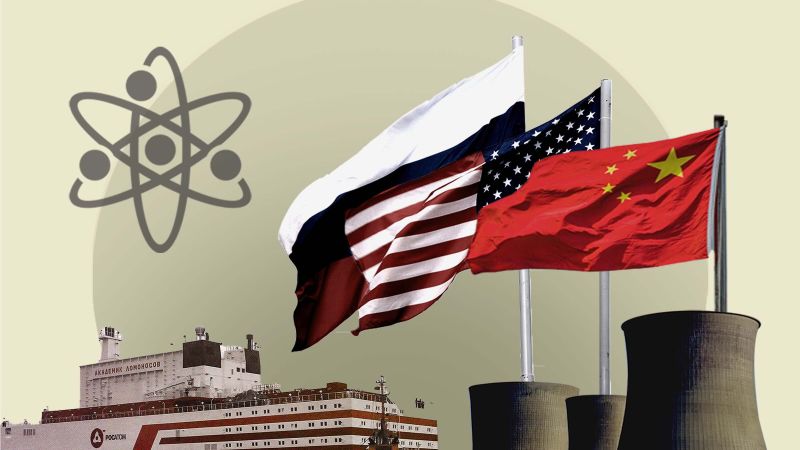Off the Siberian coast, not far from Alaska, a Russian ship has been docked at port for four years. The Akademik Lomonosov, the world’s first floating nuclear power plant, sends energy to around 200,000 people on land using next-wave nuclear technology: small modular reactors.
This technology is also being used below sea level. Dozens of US submarines lurking in the depths of the world’s oceans are propelled by SMRs, as the compact reactors are known.
SMRs — which are smaller and less costly to build than traditional, large-scale reactors — are fast becoming the next great hope for a nuclear renaissance as the world scrambles to cut fossil fuels. And the US, Russia and China are battling for dominance to build and sell them.
“SMRs — which are smaller and less costly to build than traditional, large-scale reactors”
They somehow forgot to mention a few key things:
They don’t actually exist yet.
They may be cheaper but they generate way less power. If you added up the cost of enough SMRs to equal one conventional nuclear plant they would be even more expensive than an already prohibitively expensive method of generating power.
What a dumb article.
They exist, what do you mean? We’ve been powering a fleet of submarines with them since the 1950s.
Yeah, it’s going to cost a lot upfront to get them commercially viable, but for the few places where renewables need assistance, I don’t see why this can’t make sense.
They exist, what do you mean? We’ve been powering a fleet of submarines with them since the 1950s.
I’m talking about methods of power generation that contribute to the grid. I thought that was obvious, my bad.
Yeah, it’s going to cost a lot upfront to get them commercially viable, but for the few places where renewables need assistance, I don’t see why this can’t make sense.
They will never be commercially viable. The reason we have always built the biggest nuclear plants feasible is because that was the only way that they made any financial sense.
One significant benefit of these would be the lack of transmission losses that plague massive plants which have to send electricity sometimes hundreds of miles. Having smaller units maintained by municipalities would be cheaper for cities far from major electrical plants.
You could make the same argument for renewables though, and they’re much, much more inexpensive.
Depends on many factors. Solar would be useful if the area had extensive terrain that could serve the city, however, in northern latitudes winter would be challenging with short days and low angle sunlight. If the situation allows, wind power could be useful, when the wind is blowing. The fantastic thing about these units is that they’ll crank out the KW day, night, no matter the season or location. They are not restricted to large generator farms with the scale of upkeep and maintenance they require. A city could be isolated in challenging remote areas and be self sustaining for their energy needs. These aren’t meant to be a “fix-all” solution for every situation, but they make tremendous sense in many applications where current methods are not ideal.
I get what you’re saying but we really should move away from needing power to be generated locally. High voltage DC can move power across huge distances with minimal loss - https://en.wikipedia.org/wiki/High-voltage_direct_current
We don’t need new nuclear in the US, we need the government to get off its ass and mandate an upgraded national grid so we can send power to wherever it’s needed. We already have the perfect conditions in the south for solar and the midwest prairies for wind, as well as offshore. Couple those with storage and there really is no case for SMRs outside of them being a way for fossil fuel companies to justify continuing to kill the planet while we wait for “the next big thing in nuclear power”.
Except long distance power transmission losses are not minimal. Depending on many factors, losses can easily be in the 5% - 10% range. With the amount of energy going through those wires, that’s HUGE. The additional complexity and inefficienies of relay stations, all add up. Having worked in the power sector for nearly a decade, I knew engineers who were celebrated in being able to squeeze an improvement of tiny fractions of % efficiency, as that resulted in millions of dollars saved throughout the year.
Are you referring to AC or HVDC?
ok so, minor addition here.
Both ac and HVDC are relatively efficient forms of power transfer.
The problem with AC is the skin effect (tl;dr is that the current is carried around the edge of the conductor, not the center, though you can cheat this as well) And the fact that AC running in a submarine cable is going to essentially act as a capacitor, and cause problems. (large losses)
AC traveling through the air doesn’t have this problem. The skin effect is less pronounced than you think because you can just use a higher voltage since it requires less current (transformers also have really good efficiencies when not saturated or undergoing other shenanigans) Also you can design the cabling to abuse this, using outer strand conductors, and then an inner structural strand, to strengthen the line.
HVDC is particularly applicable in undersea cables, due to the capacitor thing just not existing. Making it actually viable. It’s applicable above ground, but the problem is transforming between AC to HVDC and then back to AC. There are reasons to do this, for instance you may be between two grids with two different frequencies, this is the only solution in that case. You may want the grids to be able to operate semi independently (again frequency related)
The big problem with HVDC is that it’s inevitably more complicated. Prior to micro electronics we would use vacuum tubes, or prior to that, two motors linked end to end, one run on AC the other generating DC, and then duplicate that in reverse on the other side (that was also how we used to do voltage conversion in DC systems IIRC)
These days we just use semiconductors, but carrying a lot of power is hard, and expensive. (and also not perfectly efficient) There’s a reason massive boxes of copper wire and mineral oil are the standard solution. Dead simple, easy to maintain, and they quite literally just work.
Thanks for the info, interesting!
I heard about a plan to use HVDC to move solar power from Morocco all the way to the UK.
https://www.wired.co.uk/article/the-uks-wild-plan-to-use-a-giant-cable-to-catch-sun-from-the-sahara
If that’s feasible then moving solar power from Arizona to Minnesota or wind from North Dakota to New York seems feasible. One criticism of renewables is that the sun doesn’t always shine and the wind doesn’t always blow but it’s always sunny and windy somewhere and we can move that electricity around with HVDC, lessening the need for storage.
but it’s always sunny and windy somewhere and we can move that electricity around with HVDC, lessening the need for storage.
this is true. But the technicalities present are immense and would require some significant mathematical modelling in order to optimally determine the solution.
The primary issue with long distance transmission is that unless it’s one singular line, it’s really difficult to know where power is going. It’s realistically going to take the path of least resistance, but what this path is, where it is, and where it goes is complicated. If you have a long distance transmission line from point A to point B it’s much much simpler and a lot easier to deal with.
A particular example would be alaska, particularly farther north, where the sun gets really bizarre in the winter. That’s a prime candidate for anything that isn’t solar basically. Wind might even be problematic with the temperatures there. Nuclear however? Great starting point.
It’s hard to phrase it, but basically. hyper local generation is going to be more important than long distance transmission with renewables, particularly wind, it’s just more efficient that way. Even if norther solar panels produce less power than more southern panels, it might actually make sense to have them there, due to transmission complexities, losses, and just general shenanigans. (if one significant transmission line goes down an entire grid can fail)
If you were to just plonk down a plant in arizona for instance, and hook it up to the local grid. That power is going places. Where exactly? Nobody knows! It could be literally anywhere within the grid! Heres a particularly good demo of this
You could very well export lots of solar and wind, but honestly, i think it’s just going to be more feasible to properly manufacture nuclear power, until we can get fusion power to be a thing that exists. It’s stable, flexible, and we know it’ll work. As anybody would in CS would tell you, it’s a heuristics problem, and heuristics suck. They’re relatively accurate, and give good information, but they are a pain in the ass to develop. Though i guess if solar manages to do that for cheaper it just doesnt matter lol.
(also in case you’re wondering, they’re using HVDC cuz it’s undersea transmission. They might also run at different frequencies? I dont know.)
One of the less widely discussed issues with nuclear is that the bigger plants are all somewhat unique in their engineering particulars, which makes it more costly to maintain them. SMRs can be more readily standardised, which is expected to improve their economics as well as their cost to maintain.
If I’m not mistaken SMRs also handle power demand shifts better and don’t have to just do a base load. Something very useful with the growth of renewables and how they are not always supplying power.
Renewables being unable to do base load is just a myth that has been debunked countless times.
I’ve love for just one of the people anonymously downvoting to chime in. What you wrote is completely accurate but every nuclear-themed post here and on Reddit is downvoted without anyone putting forward a counter-argument.
Surely there wouldn’t any astroturfing be going on here, would there?
I don’t think it’s astroturfing, it’s just cognitive dissonance. Lots of people were raised thinking that nuclear power was the future and they can’t let go of that. That’s why they downvote without commenting - there’s no factual case for new nuclear and that goes double for SMRs.
there’s no factual case for new nuclear and that goes double for SMRs.
there absolutely is. It’s a good transitional source of power that we currently understand very well, and know how to manage, but simply cannot build. It would be a very prudent way of ensuring some “insurance” time before fusion starts being even remotely viable.
Although i don’t think SMRs are the correct answer here.
It’s a good transitional source of power
Not with the design and build times new nuclear has. It can take 10-15 years to build a plant, and during that time costs will usually spiral and schedules will slip. At the same time, renewables and storage will have gotten even more competitive.
To my understanding we don’t have an energy problem. We have a problem of industrialization in combination with global capitalistic tendencies. No wonder the article mentions the following:
The International Energy Agency, which outlined what many experts say is the world’s most realistic plan to decarbonize, sees a need to more than double nuclear energy by 2050.
Also, taking into consideration how dangerous nuclear accidents are, not only I don’t feel any safer with this technology -no matter how much it is praised- I feel literally scared when I hear statements like:
But a nuclear renaissance is coming, the IEA says.
The risk of anything whatsoever happening to any given individual from nuclear is miniscule compared to the very real risk to literally everyone everywhere posed by coal and gas power…
We’re all on a runaway train barreling towards catastrophe, and you’re essentially saying the bathroom needs a floor mat so someone doesn’t slip and fall. That’s about how the risks compare
If that’s your take on my comment(s), I would suggest you take a 2nd look at them.
statistically they have a point. Coal mining has killed SEVERAL orders of magnitudes more people over its history, even oil and gas are relatively dangerous compared to nuclear. Nuclear is inline with both wind and solar roughly with the amount of yearly sustained injuries.
Personally, I don’t care about these statistics. The point I was trying to make was that under capitalism any industry has the goal to make huge amounts of profit. Coal, nuclear you name it. Nothing is about sustainability, unless it is related to greenwashing. So I don’t trust their approach, including the safety of these places. Also the need for more power is for industry expansion, not to heat our homes for instance.
[By the way, I am not a communist. Mondragon is a model of non-capitalistic industrial development that has been successfully expanding since the 1950’s. By no means am I saying their approach is perfect, nor that perfection is the goal. Their example is important tho cause we can learn from them. For the Cleveland Model, they used Modragon’s input. They refers to Gar Alperorovitz amongst others]
The problem as I see it is all your statements are “I feel” and “I fear” with no sources about anything either way.
The following is related to SMRs:
And on the problem of Indutrialization some elements can be found here:
What Are Some of the Drawbacks of Industrialization? - InvestopediaSummary of “Seventeen Contradictions and the End of Capitalism” by David Harvey
Would the above satisfy you @JungleJim?







